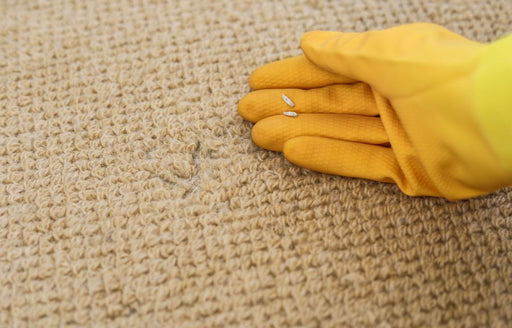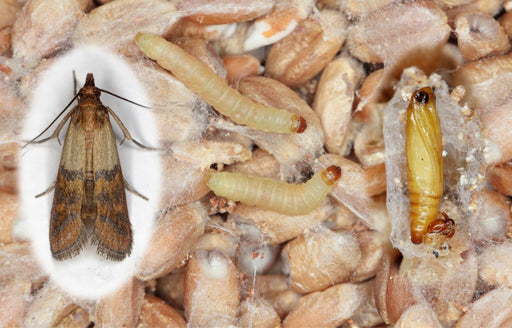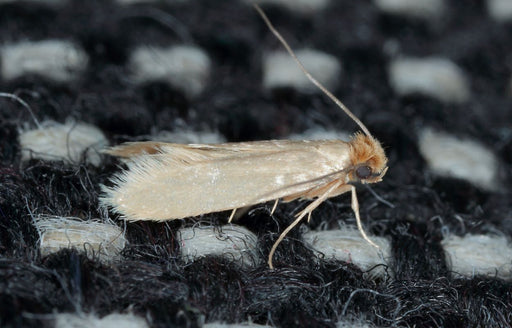How to Get Rid of Moths and Prevent Them in Your Home

No one wants to come home to find moths in their bedroom or kitchen. Moth larvae can eat through expensive clothes, stored food, and a range of other items that you probably don’t want being munched on. So what should you do to keep your stuff safe and your sanity intact?
When it comes to household moths, prevention is always better than dealing with a full-scale infestation. You can take many preventative measures to keep these dusty, winged pests out of your house. Still, if you don’t know how to keep moths out effectively, sometimes infestations will ensue. If this is the case, knowing how to remove moths right away is essential.
In this comprehensive guide, we’ll cover everything you need to know about getting rid of different kinds of moths in the house and preventing them from ever coming inside. That way, you can enjoy your home without any unwelcome little roommates!
General Advice for Moth Removal
First off, let's go over a few tips for getting rid of moths in general. Then, we will cover how to remove specific types of pestilent moths in the house.
Identify Your Moths: Are They Harmless or Pests?
First off, you will have to figure out what kind of moths are actually invading your home. Are the lights inside or on the exterior of your house attracting harmless, seasonal garden moths? Or, do you have a more serious problem, like Clothes Moths in your closet or Pantry Moths in the kitchen?
Harmless Moths Can Simply Go Back Outside
The occasional Miller Moth that flutters inside your home in search of a lamp to bash into won't usually cause you any serious problems. Even though they are creepy, you can usually just usher these guys back outside. A magazine or a throw pillow could be utilised for this ambition. If these moths really bother you, consider turning your porch lights off at night and closing your shutters if the lights are going to be left on indoors.
Pestilent Moths Must Be Eliminated with Care
Not all moths are harmless; some are genuine invaders. Nuisances like Pantry Moths, Clothes Moths, and Carpet Moths, can be a legitimate issue in the home, capable of causing a lot of destruction. These moths should be dealt with straight away, hopefully before they can lay their eggs in your house.

Clean Your Home and Freeze the Potentially Infested Items You Want to Save
If you already have a moth infestation, the best thing you can do is deal with the problem immediately. The sooner you start cleaning things up, the less damage you are likely to have to contend with.
You'll want to throw away any heavily infested items. If there are articles that you suspect may be harbouring moth eggs or larvae but do not want to throw away, you can freeze them in a plastic bag for 72 hours. Then, start by thoroughly cleaning all contaminated places and use moth-killing sprays. When you’re done, place Moth Traps to prevent the recurrence of these invaders.
Getting Rid of Moths in Your Home: A Complete Guide to House Moth Removal
Now, let’s cover how to get rid of house moths. Moth removal and prevention are easier if you understand what species you're actually dealing with. With that in mind, let's go over how to get rid of some of the most common pestilent moth species found in America, Canada, and the United Kingdom.
How To Get Rid Of Pantry Moths
Pantry Moths are some of the grossest insects to find in your house. This is because their larvae actually infest food items. Imagine scooping a cup of flour into a bowl only to realise that there are gross little worms crawling around in the dust! No thanks.
Understanding Pantry Moths
Pantry Moths are pests that, as the name suggests, infest pantry spaces. However, they can also make a home in cupboards, drawers, or even barns where you keep bird seed or animal feed.
Otherwise known as Indian Meal Moths, their larvae can eat all kinds of dry goods and are able to chew through packaging like paper, cardboard, and even wicker, to get to their desired food sources. These pests prefer dry grains like flour, cornmeal, and cereal, but can also get into spices, sugar, oats, and much, much more.
Female Pantry Moths may lay their eggs in the corners of food packaging, inside paper bags, or anywhere else that they deem as an appropriate food source for their larvae. Sometimes, this even includes unopened food items at grocery stores. Ergo, you could accidentally carry Pantry Moth Eggs into your house without even knowing it.
The larvae of the Pantry Moth hatch and begin chewing through anything and everything in the vicinity that’s edible. In time, the larvae will pupate, emerge as adults, and the breeding/egg-laying cycle will repeat.
Identifying a Pantry Moth Infestation

Most people discover Pantry Moths in the larval stage. You might notice small brownish or tan worms crawling around in your flour or cornmeal. Or, you may find sticky webs in the corners of food boxes or containers. These are all signs of a Pantry Moth infestation. Adult Pantry Moths are small, light brown, and may have dark-coloured pointy heads. They are weak flyers and usually avoid light.
Removing Pantry Moths
Removing a Pantry Moth infestation consists of throwing away heavily infested food items, cleaning your cabinets, drawers, cupboards, and pantry spaces, and storing foods in airtight containers that can not be chewed through.
It is unwise to use moth bombs or insecticides to get rid of Pantry Moths. These chemicals are not safe to use around food or in the kitchen. Instead, remove, seal, and throw away infested items. If items near an infestation are unopened or you don’t want to toss them in the trash, freeze them for 72 hours to kill any hidden eggs or live larvae.
Next, spray and clean all surfaces in an infested space with a pantry friendly cleaning agent. Be sure to get deep in cracks and crevices. Then, wash dirty food containers in the dishwasher on the sanitary cycle or with hot soapy water. Clean off cans, plastic bags, and anything else you think could be harbouring eggs
Place non toxic Pantry Moth Traps in areas where you expect moths are present.
Preventing Moths in the Pantry
Pantry Moths may be a nuisance, but they are preventable.
- Always inspect any items that you bring home from a grocery store (especially if these items are in cardboard or paper bags) thoroughly for signs of damage.
- Look for holes chewed in the corners of these items and watch for sticky webbing on any surfaces.
- Store your grains and dry goods in airtight plastic or glass containers.
- If items are expired, throw them away. Don't keep opened bags of flour, cornmeal, etc., in your pantry.
- Be especially careful with bird seed and dog food, as these can both be prime targets for Pantry Moths.
What Else to Know?
Pantry Moths like dark, secluded areas where they can find quiet places near a good food source to lay their eggs. The recesses of your pantry, such as high shelves, are often a target for Pantry Moths. Spice drawers with half-used baking mixes can be another place that Pantry Moths like to visit. Keep an eye out for these pests throughout the year, and clean your pantry regularly, throwing away anything open or expired to help keep Pantry Moths at bay.
How To Get Rid Of Clothes Moths

Clothes Moths are another pestilent type of moth. These moths love to invade closets, wardrobes, attics, and other dim, quiet places where high-quality clothing made from animal based fibres may be stored for long periods of time, undisturbed.
Understanding Clothes Moths
Adult female Clothes Moths will seek out quiet, dark areas to lay their eggs. Once the eggs hatch, hungry larvae emerge and begin eating the keratin fibers nearby. This may include:
- leather
- feathers
- silk
- angora
- cashmere, and so on.
However, sometimes they will also eat cotton or hemp if it is soiled.
Once the larvae mature, they grow into adult moths that mate, lay eggs, and continue the life cycle. Thus, many generations of Clothes Moths could breed in an attic over the course of a year or two. Vacation homes, older houses, cabins, dark attics, high shelves in garages, and wardrobes in guest rooms, are a few places that are often visited by female Clothes Moths looking to lay eggs.
Identifying a Clothes Moth Infestation
Small holes in your clothing may indicate the presence of Clothes Moths. Or, you could find dead larvae and casings in drawers or at the bottom of a wardrobe. Dead adult moths and live larvae are other common indicators of these pesky invaders. In the adult stage, Clothes Moths are silver, grey, or tan with tattered wings. They are small, weak fliers and measure less than half an inch long. Their larvae resemble small brown caterpillars.
Removing Clothes Moths
To remove Clothes Moths, first figure out where an infestation is heaviest. Then, begin bagging up all cloth and fabric items that may be infested. Large plastic trash bags are good for this purpose so that the infestation does not spread. Freeze any bagged, infested items for up to 72 hours if you believe that they can be saved. You can also haul them off to a dry cleaner if you prefer. Just keep those bags tied shut!
Once all items are removed from the infested area, begin cleaning it thoroughly. You can use moth-killing sprays or moth bombs to kill Clothes Moths if you want. Or, spray everything down with a solution of vinegar and water. Pay special attention to crevices, cracks, creases, the undersides of furniture, and all dark recesses. Once you have cleaned and wiped everything down, sweep, mop, and vacuum thoroughly.

Preventing Moths in Your Closets
Clothes Moths are attracted by scents and pheromones. As such, if an area has been visited by Clothes Moths once, there's a chance that they may visit again. For this reason, prevention is a very important part of keeping Clothes Moths from destroying your favourite high-quality items.
- You can position Clothes Moth Traps in areas where you have seen moths or suspect that moths may be present. These Traps are great for catching the active adult male moths which are lured to the sticky strip by powerful female moth pheromones. Eliminating the adult males helps break the breeding cycle.
- Store natural fabric items in plastic bins or clothes totes that are airtight.
- Clean your clothes before putting them away.
- As an added precaution, you can also add sachets containing cedar and moth-deterrent herbs like rosemary, thyme, and mint, to any airtight bins where you will be storing cashmere, wool, furs, or other textiles that these moths might target. (This can help deter moths, though it won’t prevent them.)
How To Get Rid Of Moths Naturally
Pesticides can be dangerous to use around pets and children. Not to mention, you probably don’t want these chemicals sprayed all over your house. This is especially true in enclosed areas like pantries or closets. Luckily, there are plenty of ways to get rid of moths without the use of chemical pesticides or other harsh insecticide sprays.
- Remove your belongings and deep clean any infested areas. Remove all infested items and either treat them or throw them away. Bags or clothes and food can be frozen for 72 hours to kill any moth larvae or eggs that are hidden. Then, you can use a simple mix of soap and warm water to wipe down all surfaces near an infestation site. After cleaning thoroughly, thoroughly vacuum any crevices and cracks.
- Use natural moth-killing solutions. There are many ways to kill moths without the need for pesticides or chemicals. There are natural residual sprays which are safe to use in your kitchen. Be sure to spray the solution in hard-to-reach spots such as the undersides of cabinets, inside corners of drawers, and even the walls.
- Store food and clothes properly. Different species of moths are attracted to different things like animal-based fibres or dry goods. So, store clothes and food properly using storage bags or airtight containers to prevent an infestation from returning. Take special care to store furs, feathers, wool, cashmere, silk, angora, and other animal-based fabrics, in airtight plastic bags or containers. You can also keep grain items such as flour, sugar, and cereals, in airtight containers in your freezer. Not only will this keep moths out, but it can extend the shelf life of these products.
- Set pheromone traps. Once you have removed all traces of an infestation, you can start taking natural steps to prevent moths from getting into your house and laying eggs again. The best natural moth-repellent method is pheromone moth traps. They're safe, they work, and they aren't particularly expensive. Set pheromone moth traps in spaces where moths may be likely to congregate or visit. That way, if moths do get in, the active male moths will head for the pheromone traps and be caught before they can mate and lay eggs. These safe and effective traps should always be placed in areas where you are concerned moths may try to make a home such as closets, attics, large wardrobes, vacation homes, etc. Herbal moth-repellent sachets can also be used near your doorways, windows, or in clothes storage bins. They can sometimes keep moths from wanting to investigate a space. To make these sachets, combine dried mint, lavender, thyme, cedar shavings, and rosemary.
FAQs on How To Get Rid Of Moths In House
If you are in a hurry, here are a few frequently asked questions on how to get rid of moths in your house.
How do I get rid of moths quickly?
To quickly rid your home of moths, throw out heavily infested items in airtight bags so that the infestation does not spread throughout your home during the cleaning process. Clean infested areas thoroughly, freeze clothing and textiles that show signs of moth damage for 72 hours, and when you are done set moth traps so that these pesky visitors don’t return.
What causes moths in the house?
Pest moths may be attracted to your home for several reasons. Some kinds of moths are attracted to dry goods in the pantry, while others are attracted to animal-based fibres in clothing items such as wool, silk, cashmere, leather, furs, and angora. Most pestilent moth species prefer dark, quiet, undisturbed places where they can lay their eggs.
How do you get rid of inside moths?
If a moth has flown into your house because it was attracted to a light source, you can simply shoo it back outside. However, if you are dealing with a full-on infestation of moths in a closet or pantry, you will need to thoroughly clean all infested areas and take preventative measures to keep pests from returning.
How do you permanently kill moths?
Moths can be killed using insecticide sprays, pesticides, moth bombs, or natural sprays for kitchen and pantry areas. Pheromone Moth Traps can also be used to catch and kill adult male moths before they can mate with the females and breed in your home.
About MothPrevention
MothPrevention® speak to customers every day about their clothes moth issues - clothes moths are a species that are ever increasing and that can cause significant damage to clothes, carpets and other home textiles.
To date, we’ve helped over 250,000 customers deal with their moth problems. We have developed professional grade solutions including proprietary pheromones and trap design engineered to the highest production standards.





